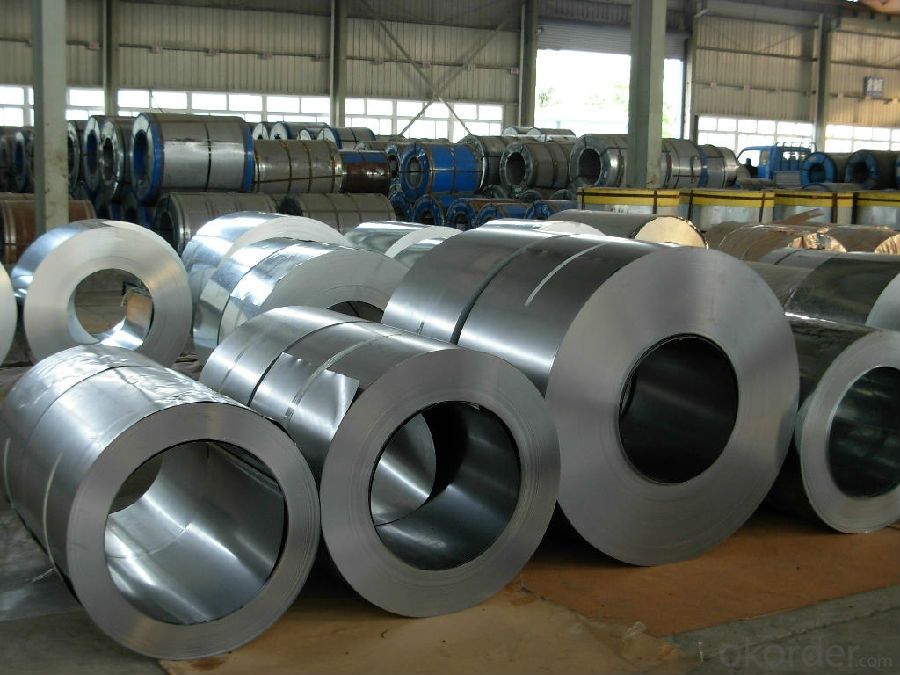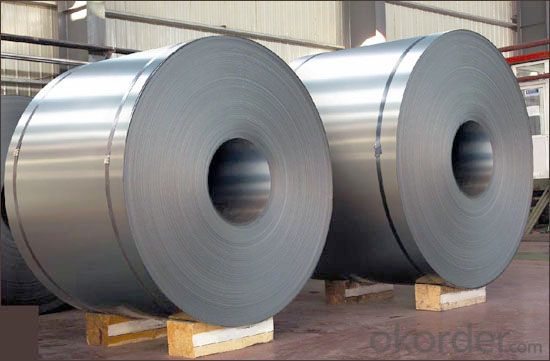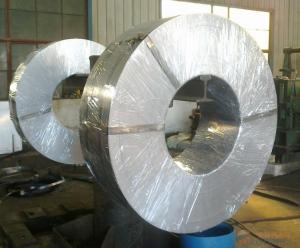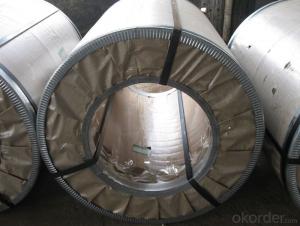Cold Rolled Steel Coil -Good Visual Effect China
- Loading Port:
- China main port
- Payment Terms:
- TT OR LC
- Min Order Qty:
- 50 m.t.
- Supply Capability:
- 10000 m.t./month
OKorder Service Pledge
OKorder Financial Service
You Might Also Like
Cold Rolled Steel Coil -Good Visual Effect China
1.Structure of Cold Rolled Steel Description:
The raw material of cold rolled steel coil/sheet is high quality hot rolled product, and after pickling continuous rolling, degreasing, annealing,skin pass,slitting and cut to length line etc. Along with it many kinds of new technology and new process of global cold rolling production have been applied. Therefore the quality of the goods could be guaranteed. The product is widely used in outdoor and interior decoration, furnishing manufacturing, home appliance, automobile etc.
2.Main Features of the Cold Rolled Steel:
• Excellent process capability
• Smooth and flat surface
• Workability, durability
• Excellent heat resistance performance
• High strength
• Good formability
• Good visual effect
3. Cold Rolled Steel Images


4.Cold Rolled Steel Specification
Standard:AISI,ASTM,DIN,GB,JIS,JIS G3302 ASTM 653M EN10142
Grade: Q195~Q345
Thickness: 0.16mm~2.0mm
Width: 1250mm MAX
Coil weight:3-12 MT
Coil ID:508/610mm
Chemical composition:
C | Si | Mn | Cr | Ni | P | S |
0.150 | 0.476 | 11.231 | 12.50 | 0.900 | 0.039 | 0.010
|
FAQ
1.How to guarantee the quality of the products?
We have established the international advanced quality management system,every link from raw material to final product we have strict quality test;We resolutely put an end to unqualified products flowing into the market. At the same time, we will provide necessary follow-up service assurance.
2. How long can we receive the product after purchase?
Usually within thirty working days after receiving buyer’s advance payment or LC. We will arrange the factory manufacturing as soon as possible. The cargo readiness usually takes 15-25 days, but the shipment will depend on the vessel situation.
- Q:can steel boil and turn into a gaseous state?? if so how hot does it have to be for it to boil
- well what for yo? melting point of steel is 800 degrees, oxidation being 1400 degrees.
- Q:Has anyone painted their appliences with stainless steel paint? I found on the internet what is called Thomas Liquid stainless steel paint. If you have used it for your kitchen appliences or cabinets, how were the results? How hard was it to apply? Would you recommend it?
- I am also considering buying Thomas Liquid Steel, but have not used it or seen it used before. I did call a store that sells this product and they said they saw the mfg demo the product at a trade show. The store rep told me that the results were absolutely amazing. I think I will buy the medium kit direct from the mfg for $129 and give it a test run first on something other than my kitchen appliances.
- Q:Is there any other way of testing whether or not you have a 1944 Steel penny that won't damage the penny. The magnet test doesn't seem to work cause even when I try to get a 2007 penny to stick to the magnet...it won't. So is there some kind of magnet needed? Like power wise or anything like that, if not then I need to know what are other ways of testing the 1944 penny.
- Weigh it. I'm not an expert on coins, but if the 1944 was 100% steel, I would expect it to weigh something different then modern pennies. Another test would be to measure the resistance with a micro-ohm meter. This is a specialized device that can measure resistance to a millionth of an ohm. Steel should have a different resistance than the metals used on other pennies. Here are some comments from wikipedia: In 1943, at the peak of World War II, cents of zinc-coated steel were made for a short time due to war demands for copper. A few (the U.S. Mint reports forty) copper cents from 1943 were produced from the 1942 planchets remaining in the bins. Similarly, some 1944 steel cents have been reported. Following 1943, salvaged ammunition shells made their way into the minting process, and it was not uncommon to see coins featuring streaks of brass or having a considerably darker finish than other issues.
- Q:How are steel coils loaded and unloaded from ships?
- Steel coils are typically loaded and unloaded from ships using cranes or heavy machinery. The coils are lifted onto the ship using hooks or clamps, and secured in place to prevent movement during transportation. Once the ship reaches its destination, the coils are then carefully lifted off the ship and transferred to trucks or other modes of transportation for further distribution.
- Q:How do steel coils contribute to energy savings in buildings?
- Steel coils contribute to energy savings in buildings in several ways. Firstly, steel coils are often used as part of the insulation system in buildings. The high thermal conductivity of steel allows for efficient heat transfer, ensuring that the building remains well-insulated and energy loss is minimized. Additionally, steel coils are often used for HVAC systems, which play a crucial role in energy efficiency. By using steel coils in these systems, the heat transfer process can be optimized, reducing the energy required to heat or cool the building. Moreover, steel coils are durable and long-lasting, reducing the need for frequent replacements and maintenance, which in turn saves energy and resources. Overall, the use of steel coils in buildings helps to improve energy efficiency and reduce energy consumption, contributing to significant energy savings.
- Q:How are steel coils secured during transportation?
- Steel coils are typically secured during transportation using metal bands or straps, which are tightly fastened around the coils to prevent them from shifting or falling off. Additionally, wooden blocks or dunnage may be used to provide stability and prevent movement within the transportation container.
- Q:Can cold rolled galvanized steel coils be acid washed after oxidation?
- If it has been galvanized, it can not be pickled, and if it is pickled, it may corrode the zinc layer
- Q:My musical saw has, despite my best efforts, got little patches of rust on it. How Do I go about removing the rust without spending too much on rust-removal products and without affecting the properties of the steel?
- Steel wool and a bit of WD 40. Steel wool will remove the rust and the WD 40 will protect it in the future.
- Q:What are the environmental impacts of steel coil production?
- The environmental impacts of steel coil production include emissions of greenhouse gases, such as carbon dioxide, during the process of extracting and processing raw materials like iron ore and coal. Additionally, the production of steel coils requires a significant amount of energy, contributing to the depletion of natural resources and increased carbon emissions. The wastewater generated during steel production can also contain pollutants, which may harm aquatic ecosystems if not properly treated. Furthermore, the disposal of steel coil waste, such as slag and other by-products, can pose challenges in terms of proper handling and potential contamination of soil and water sources. Overall, steel coil production has substantial environmental impacts that demand sustainable practices and mitigation measures.
- Q:What are the different types of corrosion protection for steel coils?
- There are various types of corrosion protection methods for steel coils. Some common ones include galvanization, which involves coating the steel with a layer of zinc; painting or coating the steel with corrosion-resistant materials such as epoxy or polyurethane; and applying a protective film or oil to create a barrier against moisture and corrosive elements. Additionally, using corrosion inhibitors in the form of chemicals or additives can also provide protection against corrosion. Ultimately, the choice of corrosion protection method depends on factors such as the expected exposure conditions and the desired level of protection.
1. Manufacturer Overview |
|
|---|---|
| Location | |
| Year Established | |
| Annual Output Value | |
| Main Markets | |
| Company Certifications | |
2. Manufacturer Certificates |
|
|---|---|
| a) Certification Name | |
| Range | |
| Reference | |
| Validity Period | |
3. Manufacturer Capability |
|
|---|---|
| a)Trade Capacity | |
| Nearest Port | |
| Export Percentage | |
| No.of Employees in Trade Department | |
| Language Spoken: | |
| b)Factory Information | |
| Factory Size: | |
| No. of Production Lines | |
| Contract Manufacturing | |
| Product Price Range | |
Send your message to us
Cold Rolled Steel Coil -Good Visual Effect China
- Loading Port:
- China main port
- Payment Terms:
- TT OR LC
- Min Order Qty:
- 50 m.t.
- Supply Capability:
- 10000 m.t./month
OKorder Service Pledge
OKorder Financial Service
Similar products
New products
Hot products
Related keywords




























